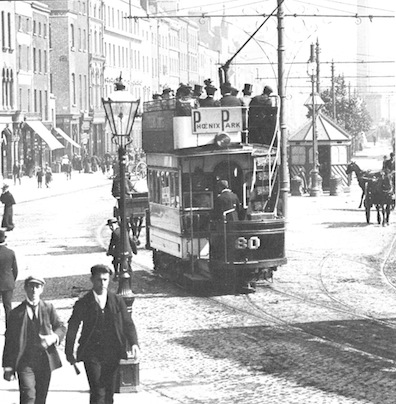After six relatively placid chapters (Nestor has
shouting schoolboys, Hades some clattering
horsedrawn carriages), Aeolus plunges the reader
into the "THE HEART OF THE HIBERNIAN METROPOLIS": lower
Sackville Street and adjoining thoroughfares, where dozens of
"clanging" trams are noisily converging and departing,
clanking presses are churning out miles of newsprint, mail
cars are lining up before the General Post Office to
receive flung sacks of mail, barrels of porter are
"dullthudding" out of a warehouse and rolling onto a barge, a
conductor is shouting out directions, and bootblacks are
drumming up business. In this cacophonous bustle, two
impressions compete: Ireland does have a city to rival other
great European capitals; but far from being purely
"Hibernian," this is a conspicuously imperial capital.
Joyce begins his cameo portrait of the metropolis with the
urban tram system that in 1904 was a source of great civic
pride. Over the preceding three decades tramlines had been
laid throughout greater Dublin, and by 1901 all the lines were
electrified and sported a fleet of mostly double-decker
electric trams. Bloom's repeated musings about the benefits of
running "a tramline from the parkgate to the quays" with
cattle "trucks" to avoid having to drive the animals through
the streets, and running a "line out to the cemetery gates"
with "municipal funeral trams like they have in Milan" (Hades)
reflects the spirit of civic improvement with which Dubliners
greeted an urban transportation system that in 1904 was
perhaps the best in Europe.
In Dublin in Bloomtime, Cyril Pearl quotes Tom
Kettle, "the brilliant young writer who was killed in World
War I," to the effect that "The tramcar is the social
confessional of Dublin. Sixpence prudently spent on fares will
provide you with a liberal education" (17-18). That sense of
expansive cosmopolitan communication appears in Joyce's next
vignette, the activity surrounding "the general post
office." The letters, cards, and parcels in the
flung sacks are bound "for local, provincial, British
and overseas delivery," and delivery to Britain, at
least, was quite swift. Twice a day mailboats promptly left the
enclosed harbor at Kingstown bound
for Holyhead in Wales, after receiving mail delivered by
express trains from Dublin. Other trains quickly shuttled the
mail from Holyhead to London.
But as the title of that second section, "THE WEARER
OF THE CROWN," proclaims, the "mailcars"
were the property of "His Majesty," "E.R.,"
Rex Edward VII, and every part of the efficient
system from "North Prince's street" to
Kingstown harbor existed to facilitate communication between
the two imperial capitals of Dublin and London. "Nelson's
pillar," an immense granite Doric column topped with a
heroic statue of Britain's most brilliantly successful naval leader, was erected in
Dublin in 1808, 35 years before the British got around to
building a similar one in Trafalgar Square in London. Dublin
has always been an imperial city (it was founded by Vikings),
and in the paragraphs that begin Aeolus one can hear
Joyce's recognition of the tension between aspiring to be one
of the great cities of Europe and knowing that it is one of
the key cities in the British empire.

